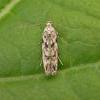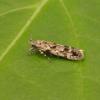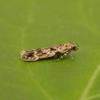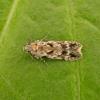35.140 Caryocolum kroesmanniella (Herrich-Schäffer, 1854)
Status and Distribution
The distribution of this rare species is imperfectly known due to confusion (covering both nomenclature and misidentification) with Caryocolum huebneri. Only accepted records have been displayed on the distribution map which indicates it has, at the very least, a particularly scattered distribution over various parts of England. Recent records indicate it may be under-recorded as these records relate to isolated and infrequently visited wooded areas.

Provisional map
Foodplant and Larval Feeding Signs
Stellaria holostea (greater stitchwort), see plant distribution map and Stellaria uliginosa (bog stitchwort).
In Europe also found on Stellaria media (common chickweed) and, exceptionally, Stellaria nemorum (wood stitchwort). It is reported that Stellaria graminea (lesser stitchwort) may also be a food-plant.
Finding the Moth
Larva: in Europe mines a leaf in the autumn and after over-wintering feeds in spun shoots in the spring. Only the post winter feeding in spun shoots has been reported in Britan.
Adult: has been found resting on the trunks of oak and comes to light.
Similar Species
This species can vary considerably in the composition of the forewing colouring. It is most likely to be confused with Caryocolum huebneri, now considered long extinct in Britain. C. kroesmanniella is larger (wingspan 12-15mm as opposed to 9-12mm for C. huebneri) and has no connecting bar between the costa and the plical spot. Potential confusion may also be possible with worn C. blandella, C. blandelloides and C. blandulella but differs in having the black streak at one quarter on the forewing with a break in the centre.
C. kroesmanniella is readily separated from all of these by obvious differences in the genitalia.
Single brooded from mid-July to late August based on less than a dozen records of the adult.
Earliest: 21st July 1962 (VC34)
Latest: 23rd August 1978 (VC66)









